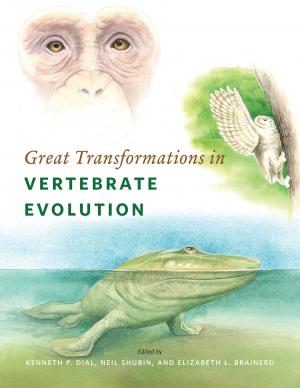| Author: | John Kuti | ISBN: | 9781301536290 |
| Publisher: | John Kuti | Publication: | September 17, 2012 |
| Imprint: | Smashwords Edition | Language: | English |
| Author: | John Kuti |
| ISBN: | 9781301536290 |
| Publisher: | John Kuti |
| Publication: | September 17, 2012 |
| Imprint: | Smashwords Edition |
| Language: | English |
This book will propose an alternate theory for evolutionary adaptation and the origin of species. The theory of bilateral subjective adaptation answers most of the exceptions to darwinian theory and offers a more comprehensive explanation for the way evolution works. It will propose that genetic adaptation is a process in which competitive and cooperative advantage are two inseparable and indivisible aspects of life that serve the bilateral shared interest / self -interest of all living creatures in every ecosystem. Shared interest / self-interest exists in the way space and time exist as the bilateral, inseparable, indivisible reality of space / time, the one inseparable from and co-dependent on the other.
Cooperative and competitive advantage exists because of the dynamic balance within shared interest / self-interest expressed in life through the subjective responses of cooperative and competitive behaviour, and it is the balance within competitive and cooperative behaviour within and among species that defines every ecosystem on the planet. Cooperative and competitive behaviour weaves together the warp and weft of shared interest / self interest in what is the great loom of life that produces the infinite tapestry of living ecosystems.
The theory of bilateral subjective adaptation will show how evolution is primarily controlled by changes in the subjective response and behaviour of living creatures and will identify nine distinct quantum leaps in subjective response that are the rungs in the ladder of bilateral subjective complexity that are the foundation of life’s infinite variation in form. The theory proposes to identify the underlying subjective structure in the ladder of life’s ascending complexity that has until now been hidden in plain sight.
The theory of bilateral subjective adaptation will also propose that new species are created by the awareness of external reality and the attendant plasticity of the dna molecule network in living creatures responding to times of great stress or opportunity within the ecosystem of individual creatures. We propose that the network of dna molecules that create every protein through which any life form responds to external environmental cues and internal metabolic needs, as well as past conditioning and learning, has within that network the ability to genetically reorganize itself to create fundamental new irreducibly complex forms and even new species. We will show that, like the brain, the network of DNA molecules in a living creature has a demonstrated plasticity to reorganize itself when its organism is fundamentally compromised or stressed. Like the brain, the network of dna molecules in living creatures has within its own plasticity the ability to create irreducibly complex new processes, structures, organs that respond to new ecological opportunity or extreme stress often atavistically reaching back even millions of years to resurrect earlier genetic forms.
For the first time in evolutionary theory, we will propose an explanation for the undeniable rapidity and multiplicity in the appearance of new species that Darwin’s theory of natural selection through slow, progressive adaptive change has been unable to explain.
This book will propose an alternate theory for evolutionary adaptation and the origin of species. The theory of bilateral subjective adaptation answers most of the exceptions to darwinian theory and offers a more comprehensive explanation for the way evolution works. It will propose that genetic adaptation is a process in which competitive and cooperative advantage are two inseparable and indivisible aspects of life that serve the bilateral shared interest / self -interest of all living creatures in every ecosystem. Shared interest / self-interest exists in the way space and time exist as the bilateral, inseparable, indivisible reality of space / time, the one inseparable from and co-dependent on the other.
Cooperative and competitive advantage exists because of the dynamic balance within shared interest / self-interest expressed in life through the subjective responses of cooperative and competitive behaviour, and it is the balance within competitive and cooperative behaviour within and among species that defines every ecosystem on the planet. Cooperative and competitive behaviour weaves together the warp and weft of shared interest / self interest in what is the great loom of life that produces the infinite tapestry of living ecosystems.
The theory of bilateral subjective adaptation will show how evolution is primarily controlled by changes in the subjective response and behaviour of living creatures and will identify nine distinct quantum leaps in subjective response that are the rungs in the ladder of bilateral subjective complexity that are the foundation of life’s infinite variation in form. The theory proposes to identify the underlying subjective structure in the ladder of life’s ascending complexity that has until now been hidden in plain sight.
The theory of bilateral subjective adaptation will also propose that new species are created by the awareness of external reality and the attendant plasticity of the dna molecule network in living creatures responding to times of great stress or opportunity within the ecosystem of individual creatures. We propose that the network of dna molecules that create every protein through which any life form responds to external environmental cues and internal metabolic needs, as well as past conditioning and learning, has within that network the ability to genetically reorganize itself to create fundamental new irreducibly complex forms and even new species. We will show that, like the brain, the network of DNA molecules in a living creature has a demonstrated plasticity to reorganize itself when its organism is fundamentally compromised or stressed. Like the brain, the network of dna molecules in living creatures has within its own plasticity the ability to create irreducibly complex new processes, structures, organs that respond to new ecological opportunity or extreme stress often atavistically reaching back even millions of years to resurrect earlier genetic forms.
For the first time in evolutionary theory, we will propose an explanation for the undeniable rapidity and multiplicity in the appearance of new species that Darwin’s theory of natural selection through slow, progressive adaptive change has been unable to explain.















